- Create
- Market
- Scale
create
market
The All In One Marketing Platform
As an entrepreneur building an online business, you’ll need many digital tools while growing your business. Various software programs make it possible to create a website, sell products, send automated emails, and perform a myriad of other critical tasks. But did you know that you don’t have to piece together individual software subscriptions? An all-in-one platform offers a more streamlined marketing solution. Read on to learn about the key features you’ll find in a high-performing, all-in-one platform.
An all-in-one marketing software gives business owners all the digital tools they need in one place. This means you don’t have to integrate numerous third-party programs, which quickly becomes inefficient and expensive — especially when you consider the cost of redundant features.
| Example of an Online Course Creator’s Software Stack | Kartra’s All-In-One Platform | |
|---|---|---|
| Website Builder | $23 / mo | Included |
| Membership Software | $119 / mo | Included |
| Email Marketing Platform | $100 / mo | Included |
| CRM / Lead Management System | $229 / mo | Included |
| Landing Page Builder | $74 / mo | Included |
| TOTAL: | $545 monthly | $189 monthly |
Rather than stacking together a costly and cumbersome suite of software, an all-in-one marketing platform, such as Kartra, offers a wide range of native functionalities for successfully creating, marketing, and scaling online businesses.
A quality all-in-one platform will have all the automation features you need to get your business off the ground, successfully market your brand, and achieve long-term business growth.

Before you launch an online business, you’ll need certain key assets in place — including a professional website and landing pages. These online assets lay the groundwork for you to reach customers and grow your business. High-quality marketing software gives you all the tools you need for this initial stage, including:
Your website represents you and your brand! It’s the foundation of your online business. This digital storefront is the place where you manage your products and services, make transactions, and engage with your customers and potential customers.
With intuitive website software, hiring a costly web developer is unnecessary. Instead, you can quickly build the website you envision with professional, ready-to-use templates — no coding required. And unlike other website builders, an all-in-one platform naturally integrates marketing functionalities with your website pages. It’s easy to incorporate surveys, pop-ups, forms, checkouts, appointment calendars, and many other features.
You’re building a tribe and you need a place to connect with them. A membership management platform enables business owners to set up members-only content, products, or services. It’s essential for establishing rapport with your members and offering them everything they need to succeed with your product – and you want them to enjoy interacting with your membership platform!
Membership site management differs depending on your business structure and pricing mode—one creator may sell their evergreen course at a fixed price, while another offers multiple membership tiers at a monthly subscription.
Your membership website platform should provide all the necessary features for managing your member base successfully — both now and as your business grows. A robust all-in-one platform like Kartra offers membership management software alongside the other features you need to market and scale your business.
Just like the name says, landing pages are where people “land” when they’re interacting with your business. Your landing pages must convey your brand and your offer – and do it beautifully.
Think about what you need from the sales pages that convert prospects into customers or the landing pages that deliver lead magnets. You want to establish trust with your audience and build your email list, and that’s why your landing page builder is important.
An all-in-one marketing platform like Kartra offers professionally-designed, done-for-you landing page templates that integrate seamlessly with your website and your automated email sequences or lead management system.
A business needs leads, right? Clearly, lead forms are a crucial part of lead generation — but not all form-builders are equal. An all-in-one platform offers customized opt-in forms that don’t just add clients to a list, but also assign detailed tags, capture information in custom fields, and even trigger automated workflows like follow-up sequences.

Once your online business is up and running, you’ll need software that enables you to consistently generate and convert leads into paying clients. Here are some of the key marketing features you’ll find in an all-in-one platform:
Email marketing is one of the most important marketing automation tools – crucial for nurturing leads and maintaining customer relationships. Email marketing automation software allows you to set up behavior-based communication that responds automatically based on subscribers’ interactions – so you can reach the right people at the right time with the right message.
Email automation through an all-in-one platform lets you create automated sequences that natively integrate with your client profiles, your website, and your sales funnels.
You can’t clone yourself, but you can take advantage of these tools to create personal touches and establish rapport with your base.
You have something to say and an audience to reach – and video can be a powerful marketing tool. Consider driving sales with product demos, building brand awareness through educational content, or hosting events for your target audience.
Many video content management options exist for uploading videos online, but they often come with other brands’ watermarks and limited customization options.
An all-in-one marketing platform comes with native video marketing software, giving you the ability to host webinars or upload branded video content that is easy to embed wherever is best for your audience.
Your client is ready to buy – and you need to make it easy for them. You’ll need an e-commerce platform to sell digital or physical products through your website. You can integrate a third-party e-commerce solution like Shopify or WooCommerce or take advantage of an all-in-one platform like Kartra that provides native shopping cart software.
This software functionality enables creators to set up an online store where customers make secure transactions using their credit card, PayPal, or other payment methods.
One of the main benefits of using a native payment processor is that it integrates easily with marketing efforts such as email campaigns. You can nurture customers toward finalizing their purchase or promote cross-selling other products or services. Say goodbye to the abandoned cart!
Lead management software automates the processes involved in gathering lead profiles, tracking leads’ progress through the sales cycle, and nurturing them into paying customers. Managing leads manually is a very labor-intensive task, and this software helps businesses owners focus their time and energy where it will have the greatest impact.
Although there are numerous CRM and lead management tools available, when this system is isolated from the rest of your marketing activities, it can be difficult to use client profiles and segmentation to your advantage. All-in-one marketing platforms allow you to do more with your customer data by providing a comprehensive view of your prospects’ interactions.
Affiliate marketing is a promotional strategy used by many online businesses. Affiliates are paid based on commissions — earning money when they successfully drive sales for your business. This essentially means having a flexible sales team without the overhead of hiring employees!
Needless to say, finding, managing, and paying affiliates requires another software subscription. But with an all-in-one platform like Kartra, you can leverage a network of affiliates from the same software that powers your other sales and marketing efforts.
A sales funnel is simply the sales process that converts potential customers into paying customers. For example, a prospect may become aware of a brand through a social media marketing campaign, then develop interest in a service after downloading a lead magnet, and finally decide to purchase after receiving an email sequence with a discount.
It’s possible to build a sales funnel manually, combining digital tools like web page builders and email software, but funnel-building software makes it simple to create automated workflows and optimize each stage of the customer journey. It also provides holistic analytics, so you can see what is working and what isn’t.
All-in-one software streamlines funnel-building even further by minimizing the number of third-party programs that have to work together to create the sales funnel.

It’s easy for startups or small businesses to be consumed by the early stages of launching a business and making initial sales. But it’s crucial to keep an eye to the future. How do you intend to grow your business? These are a few of the tools that contribute to long-term success:
Responding quickly to your customers is essential to maintaining energy and enthusiasm around your brand. It is true – quality customer support is a key factor in customer retention. As you grow, how will you stay on top of customer support?
Show your customers you care about their questions and concerns with support ticketing systems that integrate with email. This way customers won’t have to remember login information for a support portal or wait until office hours to give you a call.
All-in-one platforms not only provide help desk software that eliminates the need for external integrations, but they also securely store and seamlessly share customer data you can use to improve your marketing to repeat customers.
An automated calendar removes the need for back-and-forth communication about open slots and ensures no one gets double booked. And once an appointment is set, automated reminders will help make sure potential clients follow through.
With an all-in-one platform, your appointment booking calendar is already integrated with your website so you can easily add it to pages, pop-ups, or anywhere else you want your visitors to take the next step.
You’re busy running your business – you know data-backed decisions are the best way to find the path to growth, but it can be hard to figure out all the pieces of the puzzle.
When you have to use different analytics sources for each data point you’re tracking, it’s hard to get a holistic view of KPIs such as conversion rates or to run A/B tests effectively. You end up with disjointed engagement, conversion, and customer metrics. You need analytics that are accessible and shed light on each stage of the customer journey.
One of the most important benefits of an all-in-one platform like Kartra is your access to comprehensive analytics reports. With this streamlined marketing automation platform, you can view important, real-time data in a consolidated dashboard that is easy to access, understand, and use for decision-making.
Online business is a fiercely competitive environment, and you need software that positions you for success. When growing your business, Kartra is the best all-in-one marketing platform because its user-friendly features work together seamlessly to help you build your brand and reach more people.
As a cloud-based software, Kartra empowers you to access and manage your marketing tools from anywhere. And if you run into any questions, you need only turn to one, unified support team who’s ready to help!
So instead of managing separate software programs and incurring unnecessary expenses, choose Kartra – and spend your time and energy developing your expertise and fueling your passions.
Kartra is the all-in-one platform that enables entrepreneurs to successfully build and grow their online businesses. Find everything you need, all in one place.
Are you a solopreneur, coach, consultant, or expert looking to increase your sales into the online business world? If so, understanding the ins and outs of copywriting is essential.
In this guide, we’ll break down the importance of copywriting and how it can significantly impact your success. Whether you’re new to running a business or you’re a seasoned entrepreneur, mastering copyrighting can elevate your brand, revenue, and credibility. Join us as we dive into the fundamentals that can take your growth to the next level.

Let’s start with the basics – what exactly is copywriting? Simply put, it’s the art of crafting words that persuade and compel your audience to take action. Think of it as a virtual storefront, representing the voice of your brand in the vast digital landscape.
For solopreneurs, mastering copywriting can spell the difference between struggling to make ends meet and achieving runaway success. Whether it’s writing captivating website content, engaging social media posts, or persuasive email newsletters, copywriting is the cornerstone of effective communication in the digital space.
First Impressions Count: Your website, social media, and marketing materials are often the first touchpoint that potential clients encounter. Effective copywriting ensures you make a memorable impression, enticing visitors to explore further.
Your brand is more than just a logo or a catchy tagline – it’s the story you tell and the essence of who you are and what you stand for. By crafting compelling brand stories, conveying your unique value proposition, and showcasing your expertise through captivating content, you can establish a strong brand identity that resonates with your target market.
Whether you’re a health coach inspiring your audience to heal their gut, or a consultant offering cutting-edge solutions, great copywriting helps you articulate your brand’s values, mission, and unique selling proposition, setting you apart from the competition in a crowded marketplace.
With the right words, you can reach and resonate with your target audience wherever they are. Whether it’s through blog posts, social media captions, or ad campaigns, strategic copywriting ensures that your message cuts through the noise and reaches the people who need to hear it most.
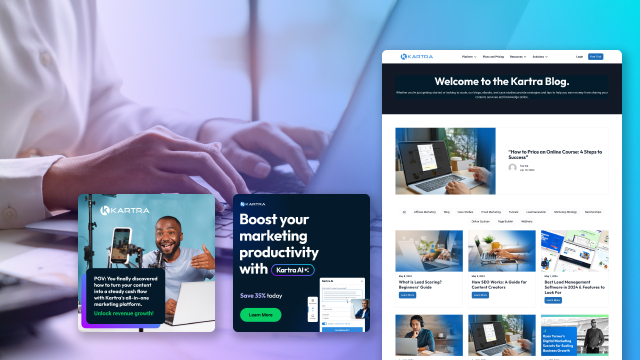
Let’s face it – you’re in business to make money. And while having a great product or service is essential, it’s only half the battle. To turn your passion into profits, you need to master the art of selling – and that’s where copywriting comes in. Copywriting isn’t just about sounding good – it’s about driving action. By crafting compelling landing pages, email marketing campaigns, irresistible offers, and a persuasive call-to-action, every word you write has the potential to drive conversions and boost your bottom line.
In the world of online business, trust and credibility are everything. And nothing builds credibility faster than high-quality, well-crafted content that showcases your professionalism and expertise in your niche. Delivering it shows potential clients and customers that you know your stuff and can deliver on your promises, earning their trust and loyalty in the process.
By consistently delivering valuable insights, actionable tips, and thought-provoking ideas through your content, you can position yourself as a trusted authority in your niche and earn the respect and admiration of your audience. Whether it’s publishing insightful blog posts, hosting informative webinars, or sharing inspiring success stories, effective copywriting can help you build a rock-solid reputation that sets you apart from the competition and demonstrates a deep understanding of your reader’s needs.

Feeling overwhelmed? Don’t worry; copywriting is a journey, not a destination and no one knows your product better than you do. Here are some practical tips to help you get started:
Here are 5 headline formulas to help you save time:





In today’s ultra-competitive marketplace, effective copywriting isn’t just a nice-to-have – it’s a must-have for every solopreneur and budding business looking to make their mark online. With copywriting, you can build a powerful brand that resonates with your audience, establishes yourself as a trusted authority in your field, and boosts your revenue.
Copywriting may seem daunting, but you don’t have to go at it alone. Tools like Kartra AI enables creators, coaches, and entrepreneurs like you to ideate, create, and craft compelling copy in seconds. Think of Kartra AI as your dedicated writing ally. With a little effort and the strategies outlined above, you can establish your brand, draw in a wider clientele, and propel yourself toward realizing your business goals and aspirations.
So, what are you waiting for? Start honing your copywriting skills today! If you’re interested in learning about how to leverage AI to write copy, read our blog: A Novice’s Guide to Crafting Powerful Prompts for Copy Generation or start a trial of Kartra and see firsthand how Kartra AI can be your personal writing partner, simplifying your content creation.
Struggling to gain traction with your marketing efforts? Video marketing could be the key to accelerating your growth. According to short-form video statistics, 72% of consumers choose video content as their top choice to discover products and services. This strong inclination highlights video’s significant impact on reshaping marketing strategies, a topic we will dive into extensively.
In this article, we’ll uncover the key strategies for crafting an effective video marketing sales funnel that not only captivates, but converts. From understanding the mechanics behind it to dissecting examples of successful marketing videos and pinpointing their position within the funnel, we’ll equip you with everything you need to elevate your video marketing game. Here’s what we’ll cover:
A video marketing funnel is essentially your strategy for guiding potential customers through their purchase journey using video content. It matches video types to the buyer’s journey stages:
At the Awareness stage, the goal is to catch the attention of your target audience. Short, engaging videos work here to generate interest and traffic. You’re looking to introduce your brand and the value you provide without hard selling.
Move into the Consideration stage with educational content that nurtures interest. Here, how-to videos or product demonstrations can help your audience understand how your offerings address their needs.
As they reach the Decision stage, more in-depth content (such as testimonials and in-depth product reviews) can help sway them toward choosing your product or service. This is your opportunity to convert prospects into leads or sales.
Finally, at the Action stage, the aim is to solidify the relationship. Customer testimonials, detailed tutorials, and personalized content can encourage repeat purchases and foster loyalty.
Throughout these stages, your video content must be crafted with clear goals. They should also adhere to a defined strategy for your target audience. Videos are an excellent medium for communication – this is why they should be memorable and engaging to leave a long-lasting impression. The type of videos and their strategic placement within your marketing funnel are key to effectively nurturing leads and converting them into returning customers.
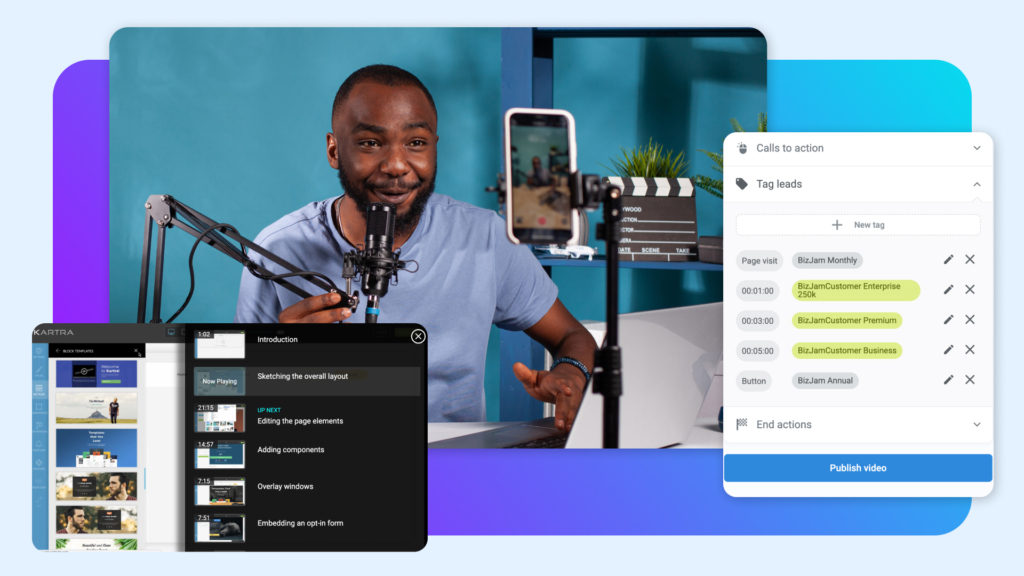
Being versatile in format and content, videos cater to a wide audience and accommodate various types of content such as explainer, demo, testimonial, educational, how-to videos, and product videos.
When you use video, you tap into the dynamic nature of visual storytelling, making it easier for your audience to remember your message. According to The Shrinking Attention Span and What it Means for Marketers, viewers retain 95% of a message when they watch it in a video, compared to 10% when reading text. Moreover, with most internet traffic being video, users are becoming accustomed to consuming content in this format.
Furthermore, video content is shareable across multiple platforms, increasing your reach and potentially your conversion rates. To put it into perspective, including video on your landing page can increase conversions by 80%.
Let’s take a closer look at what each phase of a video marketing funnel should involve, and the type of videos you should create for your campaign.
At the top of the sales funnel, your video content should focus on capturing attention and introducing your brand to a new audience.
Your goal here is to ignite interest and encourage potential customers to learn more about what you offer by creating brand awareness and driving traffic – using engaging and informative videos to grab the attention of prospects.
These can include:
Animated explainer videos are a popular choice for top-of-funnel (ToFu) content because they can simplify complex ideas and present them visually engagingly.
Crazy Egg is a prime example of a brand that effectively used an animated explainer video to introduce its heat map tool for the viewer to the masses.
The animation made the concept of heat mapping easy to understand, showcasing the benefits and functionality of using Crazy Egg in an informative and entertaining way. By doing this, the animated video helped people understand what Crazy Egg is all about, making them more curious about the service right from the start of the sales funnel.
Educational content is a powerful tool in the ToFu stage as it aims to answer questions and solve problems related to the brand’s industry. Home Depot excels in this area by providing many DIY how-to videos. These videos help customers learn how to complete projects themselves, introducing them to the tools and materials they’ll need—many of which Home Depot sells.
This approach establishes the brand as an authority in the home improvement space and subtly markets its products as solutions to the viewers’ needs. Home Depot nurtures trust and encourages further engagement down the sales funnel by educating the audience.
Live-action videos on the ToFu stage showcase real people, real stories, or real product demonstrations. These videos can create a more personal connection with the audience by featuring product features and use cases.
Let’s take Kartra, for example. They nailed it by using live-action videos to share product features and demos – from the home page to the individual feature pages.
Like in real life, these videos help Kartra showcase its features and give visitors a sneak peek of what it does and how the software solves user problems.
Watching live-action videos can make you feel more connected to the brand, bringing in a sense of realness and relatability that’s important for getting people interested and trusting the brand from the get-go.

At the Middle of the Funnel (MOFU), you’re engaged with leads who are aware of their issues and are seeking solutions. This makes it the prime stage to use informative video marketing to guide them closer to purchasing.
The goal is to provide content that educates and demonstrates the value of your product or service.
Useful video types here include:
At the middle of the funnel (MoFu), tutorial videos come into play by providing in-depth instruction and demonstrating the practical use of a product or service. These videos are particularly useful for software companies that must educate users on navigating and utilizing their platforms effectively. An example of this could be Adobe’s extensive library of hands on tutorials for its creative software, which helps users understand and maximize the potential of their products, thereby increasing the perceived value and encouraging further engagement in the sales process.
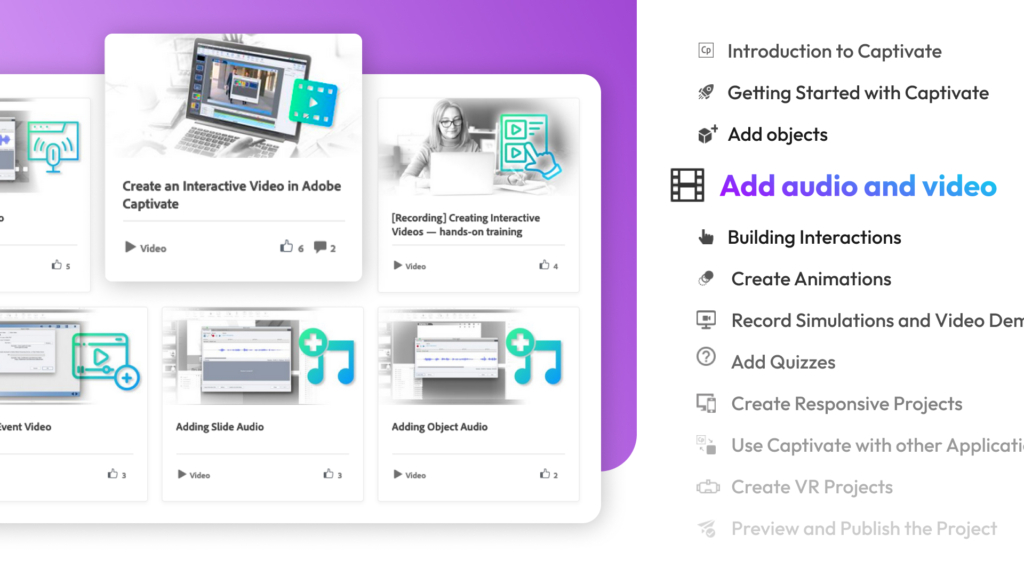
Product videos are designed to showcase a product’s features, benefits, and real-world applications.
Apple, known for its sleek product videos, creates visually stunning presentations highlighting their devices’ design, features, and innovation, often prompting viewers to visualize the experience of owning and using an Apple product. These videos inform potential customers about the product in detail and help them move from consideration to the decision-making stage.
Webinars are an effective MoFu strategy for delving deeper into subjects that interest potential customers and positioning your brand as an authority in the field. For example, Salesforce offers webinars covering various topics related to customer relationship management, providing value through educational content.
This educates potential clients and builds a relationship with them, as webinars often include a Q&A session where viewers can engage directly with the brand.
Video case studies and customer testimonials are powerful because they provide social proof and demonstrate the value of your product through the experiences of others.
These videos often feature real customers discussing how a product or service solved their problem, which can resonate strongly with prospects facing similar issues. This type of content can help to assuage doubts and reinforce the credibility of your brand in the eyes of potential buyers.
FAQ videos address common questions and concerns that potential customers may have. By providing answers in a video format, brands can ensure that the information is not only accessible but also engaging. FAQ videos can cover everything from product features, troubleshooting, and company policies to after-sales support.
Wistia is one brand that uses FAQs to demonstrate various concerns about their platform – with a whole suite of FAQ videos highlighting everything from uploading a video to using their platform for video creation.
This proactive approach helps to eliminate barriers to purchase, as prospects are more likely to convert when they feel informed and reassured.

Your aim here is to provide that final nudge toward a purchase.
At the bottom of the video marketing funnel, your content must resonate with well-informed leads on the verge of purchasing. Your videos should showcase tangible business results, highlight personal client benefits, and address any final purchasing objections.
Your leads are considering a purchase at this stage, so it’s time to convert them into customers.
Use persuasive content like:
At the bottom of the funnel (BoFu), where the goal is to convert prospects into customers, comparison videos can be highly effective. These videos compare a brand’s product directly with competitors, highlighting the unique selling points and advantages of their offering.
For instance, a smartphone manufacturer might release a comparison video demonstrating their phone’s superior camera quality or battery life compared to other market leaders. This direct approach helps potential buyers make informed decisions and can be the final nudge they need to choose one product over another.
Video Sales Letters are designed to persuade the viewer to purchase.
They combine a compelling narrative with a strong sales pitch, often including a call-to-action (CTA) at the end. VSLs are typically direct and personal and aim to create a sense of urgency. They can be particularly effective for online courses or digital services where video delivers the value proposition clearly and convincingly.
These videos give you a hands-on look at how the product works. They’re like detailed guides that go beyond the basics, focusing on the advanced features and benefits that make the product stand out.
Take Zoom, for instance. They aced it with a tutorial on how to set up the Zoom Rooms Huddle Kit. This video isn’t just about the basics – it’s a deep dive into making the installation easy. Zoom breaks it down with clear instructions and close-ups, showing exactly where to plug those connecting cables. They start by listing all the bits and bobs you need for the setup; then, a real person walks you through each step in real time.
This demo video is gold for potential customers wanting to set up Zoom. It shouts out the ease of use and cool features, making buyers confident about their choice. It’s like having a friendly guide with you, assuring you that using Zoom is a smart move.

In-depth product reviews by third parties or influencers can be a powerful tool in the BoFu stage.
These reviews are often perceived as more trustworthy since they come from an external source. Brands may facilitate these reviews by providing products to reviewers in their industry. For example, a new smartphone might be sent to tech reviewers on YouTube, who then create detailed videos about the phone’s performance, design, and features, helping viewers make a purchase decision.
Think of this final phase as the part where you get to know your customers, making them feel like they’re a key piece of your brand’s story. And let’s be real, it’s all about giving them those little nudges that remind them how awesome your stuff is.
Plenty of businesses drop the ball after they’ve sealed the deal. Big no-no.
Closing a sale is just the beginning!
You have to keep that video marketing magic going. When it comes to customer retention marketing, statistics show that acquiring a new customer can cost five times more than retaining an existing customer.
Retention videos maintain the relationship and can include the following:
Let’s explore a bit on these types of videos:
Sharing customer success stories through video is a powerful way to show the real-world impact of your products or services. These narratives can resonate with your customer base as they see themselves reflected in the success of others. By highlighting how customers have benefited from your offerings, you create aspirational content that reinforces the value of your brand and encourages continued loyalty.
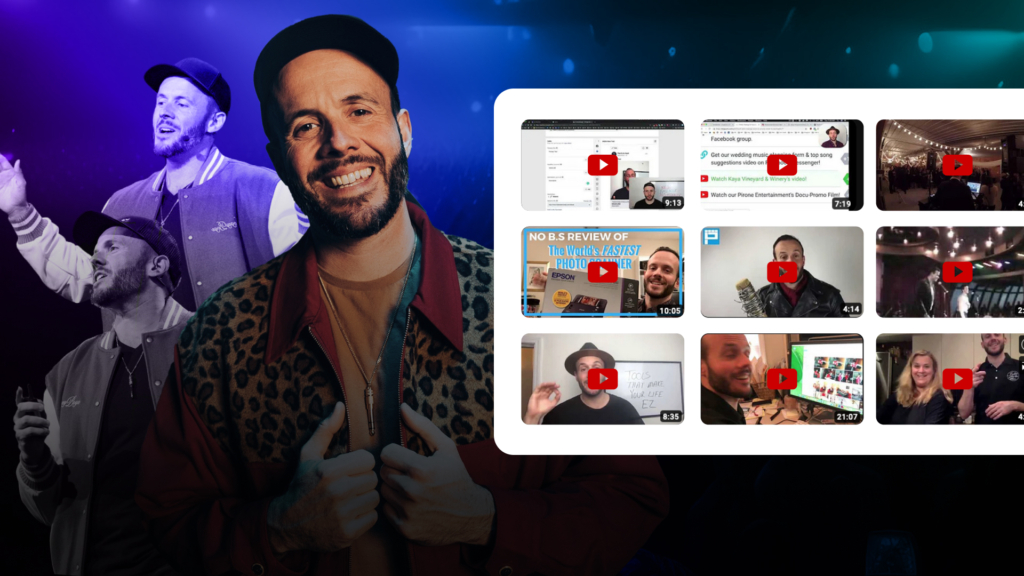
Customers love feeling valued, and there’s no better way to show appreciation than through exclusive deals. Special offers, discounts, and promo videos can incentivize repeat purchases and keep your brand top-of-mind. These videos can be personalized and time-sensitive, creating a sense of urgency that encourages customers to take action and stay engaged with your brand.
Keeping customers informed about new features or services through video content can rekindle their interest and demonstrate your commitment to improvement and innovation. These updates can serve as both educational content and a sales pitch, highlighting how the new offerings can provide additional value to the customer’s experience with your brand.
A simple ‘thank you’ can go a long way in making customers feel appreciated. Personalized thank-you videos can create an emotional connection and a positive post-purchase experience. Expressing gratitude for a customer’s business is good manners and reinforces their decision to choose your brand, contributing to customer satisfaction and loyalty.
Now that you’re familiar with the types of videos essential for a successful sales funnel let’s move on to building yours.
In the first step of creating a video sales funnel, it’s crucial to put yourself in the shoes of your potential customers. Take the time to research and understand your target audience thoroughly. Delve into their preferences, pain points, and behaviors.
Imagine you’re a detective gathering clues about their lives. This investigative work ensures that your content will be highly relevant and engaging, as it speaks directly to their needs and interests.

Once you’ve identified your audience, the next step is to set clear objectives for your video sales funnel.
Think of this as setting the destination on your GPS. Specify goals for each funnel stage – Awareness, Interest, Decision, and Action (AIDA).
For instance, if you’re a new brand, your initial goal might be to increase brand awareness. Ensure these objectives are specific, measurable, and tailored to each stage, creating a roadmap that keeps you on track and guides your content creation.
When planning your video content, create tailored material for each funnel stage.
Use videos to educate and entertain during the Awareness Stage, potentially capturing social media or YouTube attention. Aim for content that introduces your brand’s unique value.
Moving to the Interest Stage, your videos should address specific problems and offer solutions, featuring case studies or testimonials. Here, you might retarget audiences who interacted with your earlier content.
The Decision and Action Stages focus on content that nudges viewers towards purchasing, like product comparisons or FAQs. Incorporating strong CTAs is essential, urging the viewer to take the next step, whether signing up or buying.

Think of your video sales funnel as a garden that needs continuous care. Nurture leads and customers by maintaining engagement through follow-up videos. Email marketing becomes your watering can, keeping the dialogue open. Consider instructional content as the sunlight that helps new customers better understand and use your product or services. Regularly tending to your garden ensures that it blossoms and flourishes.
If you can not measure it, you can’t improve it.
Measuring your funnel’s performance through analytics is akin to checking your altitude and speed. Staying informed on the latest video marketing trends is like having an updated navigation system. Regularly adjust your content, ensuring it aligns with the evolving landscape. This adaptability is the key to ensuring your video sales funnel remains effective and stays ahead of the curve.
Building an effective video marketing sales funnel is a strategic endeavor that requires a blend of creativity and analytical thinking. Properly constructed, it can effectively guide your prospects through the buyer’s journey.
In the end, weaving a compelling video marketing sales funnel is akin to crafting a captivating story that resonates with your audience at every turn. By defining your target audience, setting clear objectives, and tailoring content for each stage, you lay the groundwork for a narrative that guides viewers seamlessly toward conversion. Like a well-tended garden, continuous optimization, nurturing, and adaptability are essential for sustained success.
Your video marketing sales funnel typically consists of three main stages: awareness at the top, consideration in the middle, and decision at the bottom. Your video content should be tailored to guide the viewer to the next step at each stage.
You must create informative content that captures attention quickly to engage viewers at the top of the funnel. Videos should be designed to address the viewer’s interests or problems, using storytelling and high-quality visuals to make an impactful first impression.
To create a video marketing funnel, first, establish your campaign goals. Then, use Kartra’s built-in video feature to map and host your videos. Segment your audience for targeted messaging and utilize Kartra’s analytics to track user engagement and optimize your funnel.
Leveraging tools like Kartra’s video marketing software simplifies the process due to its marketing-oriented capabilities, allowing seamless integration of in-video CTAs. It’s crucial to align the CTA with the specific stage of the funnel – prompting shares or sign-ups during the awareness phase and emphasizing sales or trials at the decision stage.
Khris Steven is the brain behind KhrisDigital. He’s a content marketer and publisher with 7 years of experience, specializing in sales funnels, side hustles, SEO, affiliate marketing, and marketing trends. On his blog, Khris spills the beans on how business owners can use simple marketing strategies and tools to make a real difference in their lives. Follow him on Twitter here.

The leads in your system don’t carry equal potential for a sale. Some leads line up with your ideal customer profile more than others or are more actively engaged with your brand. Lead scoring is an important process that categorizes these sales leads so you can manage your resources effectively and personalize buyer journeys. Read on for details about how lead scoring works and how to use it effectively in your business!
Lead scoring is a way to measure lead quality — assigning a numerical value to a lead based on user characteristics and/or user behavior. A higher score indicates that a lead is a strong fit for your product or highly engaged with your brand, or both. A lower score indicates that someone is less likely to buy because they’re not the right fit or not interested in buying, or both.
While it’s possible to manually track and sort leads, automation has taken lead scoring to the next level. Website forms capture lead information, lead scoring software assigns point values based on your rules, and automated workflows integrate with your lead management software to nurture leads on autopilot.
The specific factors that indicate someone is a “good lead” will depend on your business and target audience. But two main types of criteria you’ll want to consider are user characteristics and user behavior.
User characteristics include factors such as a lead’s job title, industry, location, age, or personal goals. Demographic data is a big part of this category of scoring factors. The lead capture form gathers these straightforward details that tell you something about who the prospect is and whether they’re a good fit for your products or services.
For example, a career coach could use lead scoring to prioritize leads with particular job titles, finding that people in certain roles tend to be the most eager learners. The coach’s inquiry form would need a field where the lead specifies their role, alongside any other relevant details — such as their industry.
Behavioral data includes a more complex set of lead-scoring criteria that tell you something about a lead’s level of interest in your brand and intent to buy. These factors include email open rates and click-through rates, content downloads, website visits, and any other type of action someone takes on your website or through other marketing channels.
For example, someone who signed up for a free trial on your pricing page is almost certainly a better lead than someone who signed up for a newsletter. And someone who attended an hour-long webinar is probably a better prospect than someone who downloaded a whitepaper. Certain actions indicate stronger intent than others — but you’ll have to track the conversion data to find out what those actions are!
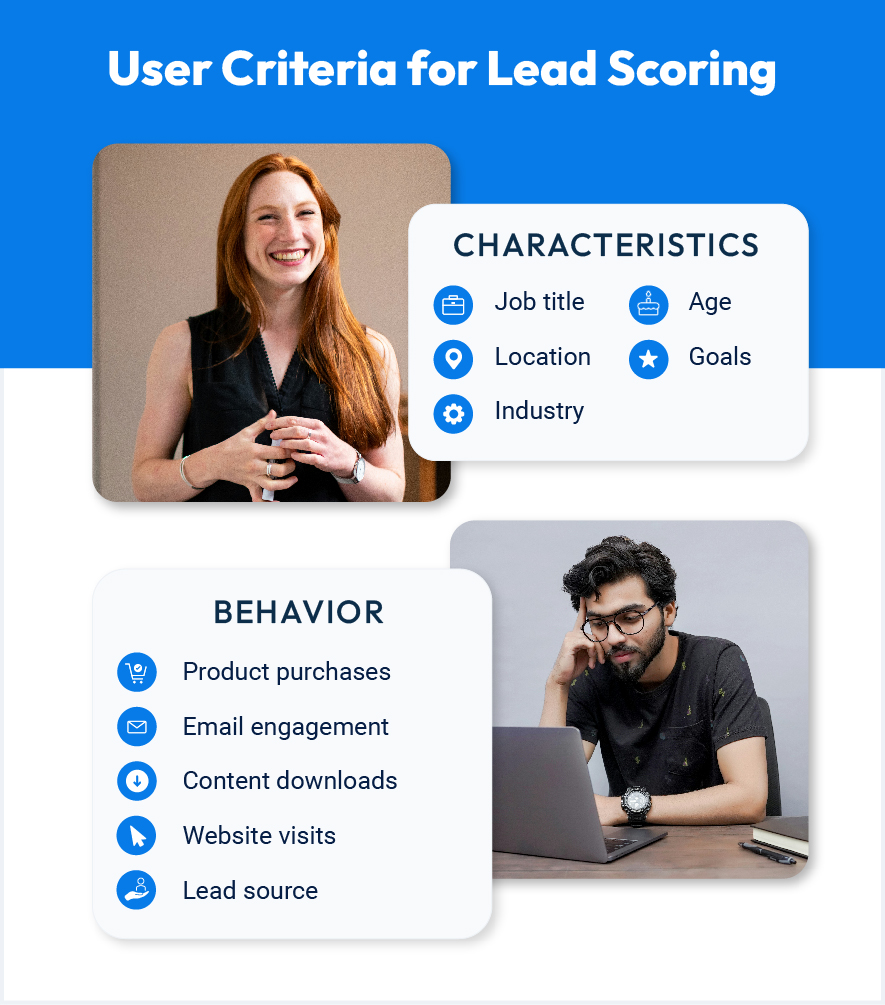
Assigning negative points to leads is a convenient way to automatically remove leads from lead nurturing sequences or ensure they don’t end up on a high-priority list. Leads can be disqualified based on behavior patterns such as unsubscribing from emails or user characteristics like their location or job title.
Lead scoring models vary from business to business — it’s important thing to set the rules and goals for your scoring model ahead of time so your methodology is consistent.
One of the simplest ways to calculate lead scores is to set a maximum score of 100 and divide up the points between each of the factors that contribute to the score. If you decide to score leads based on both user characteristics and user behavior signals, you could set a maximum of 50 points per category to account for both types of criteria.
If you’re wondering where to get started, analyze current conversion rates to determine the relative importance of each factor based on what you observe. You can also test factors that you have reason to believe are important from your own experience. And it’s a good idea to talk to or survey your customer base to understand more about your ideal customer and their buyer journey. There might be key behavior signals or shared characteristics of great leads that don’t show up in analytics reports.
Your scoring model will begin with educated guesses, and you will adapt your strategy over time. The first lead scoring model you try will inevitably need to be adjusted as you test different scoring factors, analyze ongoing conversion data, and learn more about your audience.
Predictive lead scoring leverages machine learning to streamline the lead scoring process even further. Predictive scoring software uses advanced algorithms to adapt your lead scoring model for the future — ”predicting” who the best leads will be based on past data points.
The most impactful uses of your lead scoring system will depend on your company size and structure, but there are some universal advantages to prioritizing your leads by their sale potential. Here are a few ideas on how to get the most value out of lead scoring:
Perhaps the most practical use for lead scoring is streamlining internal sales processes. This is particularly true for a business with a marketing and sales teams trying to work in alignment. Lead scoring helps make sure the sales reps focus on qualified leads who are worth their time.
Using your time effectively is essential no matter whether you have a dedicated sales team or run your own online business – and lead scoring is a key tool for resource allocation. This doesn’t mean you or your sales reps should only follow up with the potential customers most likely to convert. That’s up to you. However, lead scoring does help ensure that high-value leads are less likely to fall through the cracks.
Lead scoring isn’t just a practical necessity for pipeline management, it also opens many opportunities for personalized lead nurturing that boosts conversion rates. When you integrate lead scoring with sales funnel software, you can set up automated workflows that are triggered when a lead reaches a certain threshold.
For example, your most engaged leads could be sent down a marketing path where they receive conversion-focused content such as discounts, upsells, and cross-sell offers. Meanwhile, less invested leads would continue to receive primarily educational content that builds trust over time.
Native API functionality or third-party tools like Zapier enable you to connect separate lead management and marketing software applications. Alternatively, you can unite your sales and marketing efforts with an all in one platform like Kartra. Kartra provides lead management and email marketing functionalities that work together, no integration required.
A lead scoring system will provide you with valuable insights about your customer base, your brand, and your marketing efforts. For example, if your highest-scoring leads consistently come from the same lead source, this tells you a lot about which lead generation tactics are working best. Or, you may identify common characteristics among people who resonate with your brand‚ — such as their job title or goals. Consider how you can put these insights to use as you update your ideal customer profile and optimize marketing campaigns at a higher level.
For lead scoring to be a natural part of your business operations and not another manual task, you’ll need certain software applications. These tools save time and effort by automating lead management and marketing processes:
Sales and marketing analytics are the foundation of any lead scoring system. Scoring is a data-driven method for sorting leads, requiring an accurate picture of the customer journey. You need to know who is interacting with your business (user characteristics), how they engage with your brand (user behavior), and how those factors relate to sales (conversion data).
If your business takes advantage of multiple marketing channels, you likely have a variety of analytics dashboards — covering website interactions, email engagement, and other key metrics. One of the best ways to integrate all this data is by using an all in one platform for marketing and lead management, such as Kartra.
A lead management platform is the primary tool you’ll need to implement lead scoring. A quality lead management system will organize and segment your new leads, allow you to assign rules for lead scoring and tagging, and track your leads’ journey through the sales cycle.
This software should integrate with your email marketing platform, sales funnel builder, and any other tools you use to engage leads and customers. Or, choose an all in one platform like Kartra for native lead management tools and marketing automation tools that are designed to work together seamlessly.
A form builder is necessary for capturing lead information in the first place. From contact forms to email sign-up forms, opt-in forms are important touch points along the customer journey. A quality form-builder will feature professional templates, drag-and-drop functionality, and the ability to customize form fields to the level of detail that you need. It should also integrate seamlessly with your lead management platform so contact details stay accurate and organized.
When choosing a lead scoring tool, it’s important to look beyond its immediate functionalities for sorting leads. How do you intend to use the details you’re gathering about those leads? If you want to set up automated sequences and customize buyer journeys according to lead scores, your lead management system will need to integrate well with your sales funnel builder.
For seamless integration, choose an all in one lead management and marketing platform like Kartra. Kartra’s full slate of native features — including a lead management system, form builder, and sales funnel builder — align marketing and sales activities so you can stay organized and optimize buyer journeys for higher conversion rates.
Coaches, consultants, and all types of content creators stand to gain a lot from investing in search engine optimization (SEO). Showing up on the first page of Google for relevant searches is a long-term marketing strategy that drives brand awareness, builds trust with your followers, and leverages the largest source of website traffic that exists today! Read on to learn about why SEO is valuable for content creators and how it works.
Content SEO is the practice of developing digital content that ranks well on search engine result pages (SERPs) for key terms. Content SEO encompasses both content strategy and actual content development, and it applies to all types of web pages — product pages, blog posts, landing pages, and more.
SEO draws attention to the role of search engines (especially Google) in getting content in front of users, but remember that creating content for search engines is never the goal. Content SEO — like any content creation — is for the benefit of your audience! Keep reading for details on how SEO works and what it means to create SEO-friendly content.
Think of technical SEO as the behind-the-scenes strategies that improve your website’s performance. Technical SEO practices include improving page speed, developing meta descriptions, and fixing broken links. While subject matter experts and content creators can implement content SEO strategies themselves, technical SEO fixes are best accomplished by web developers.
Many content creators use their website as a home base — somewhere people go to learn more about their brand after finding out about it from a different source (such as social media or a word-of-mouth referral). While this is an important use for certain website pages, it doesn’t leverage your website’s full potential. Optimizing your website for SEO offers some significant benefits.
Even with the rising popularity of social media, Google is still the biggest driver of referral traffic by far. According to research conducted by Sparktoro, most websites get over 70% of their referral traffic from Google.
With millions of people searching for answers on Google every day, optimizing your website to be search engine friendly is an opportunity you can’t miss! SEO takes time and patience, but the return on investment is high — especially when you consider the costs of alternate marketing channels such as paid advertising. When a website is optimized to rank well in search engines, it becomes its own lead-generation tool.
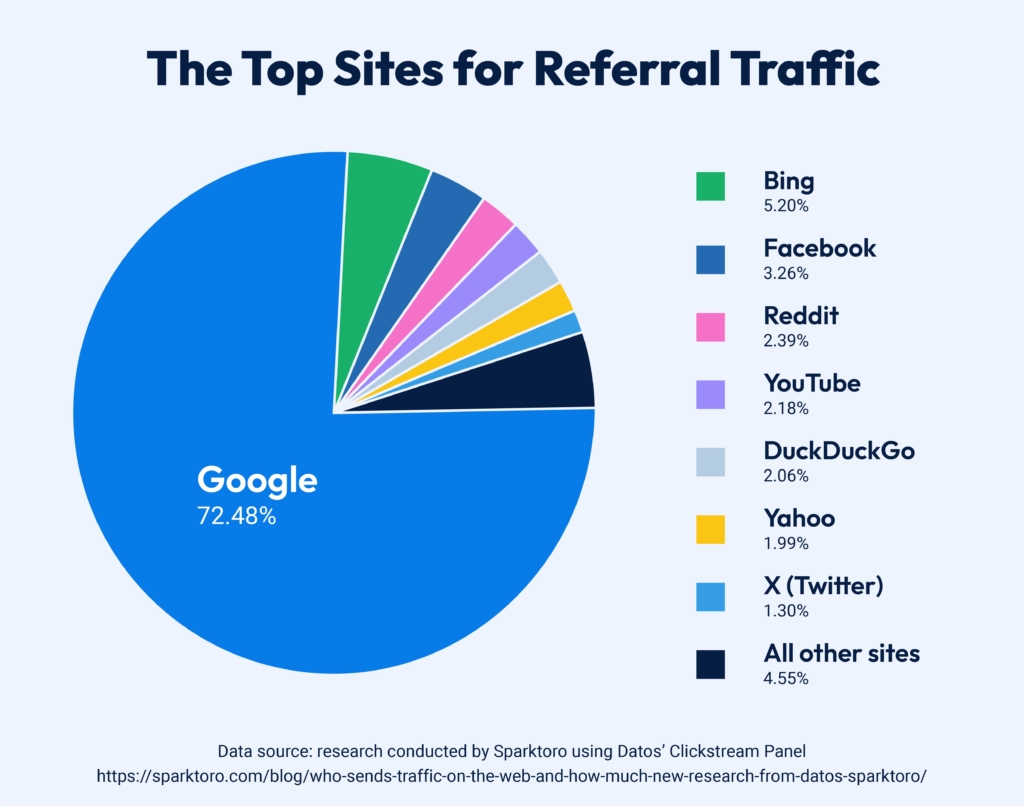
Data source: research conducted by Sparktoro using Datos’ Clickstream Panel
One of the biggest difficulties when generating sales leads is controlling the quality of those leads. Brand visibility is most valuable when visitors align with your intended audience. Because the role of a search engine is to match online queries with highly relevant pages, this gives you a level of control over the types of visitors who discover your brand.
When the relevance of your website is clear to a search engine (and the user), you’ll be better positioned to appear in searches that reach the audience you want.
Establishing trust with your audience is essential to sustainable brand growth. When your website consistently appears in relevant search results, you signal to your audience that you are an authority in your field and worth their attention.
And unlike a viral ad, for example, search engine optimization is a strategy with long-term benefits for your brand. When Google perceives that your website is highly valuable for users, there’s an increased likelihood of ranking well as you publish more pages with helpful content.
Search engine software uses crawlers to index and rank website pages. The purpose of a search engine is simply to match an online search query with the best possible result — the one that will be most helpful to the user.
This means that writing content for a search engine is counterproductive. It’s also why keyword stuffing and other “black-hat” SEO tactics don’t work long-term — they don’t give users what they want.
Optimizing content for SEO isn’t about technical hacks or tricks for getting content to rank. It’s about making your website content as helpful as possible to your target audience. And remember that effective SEO content strategy is about the long game. It takes time to build authority in your industry and prove to people (and search engines) that you’re worth listening to!
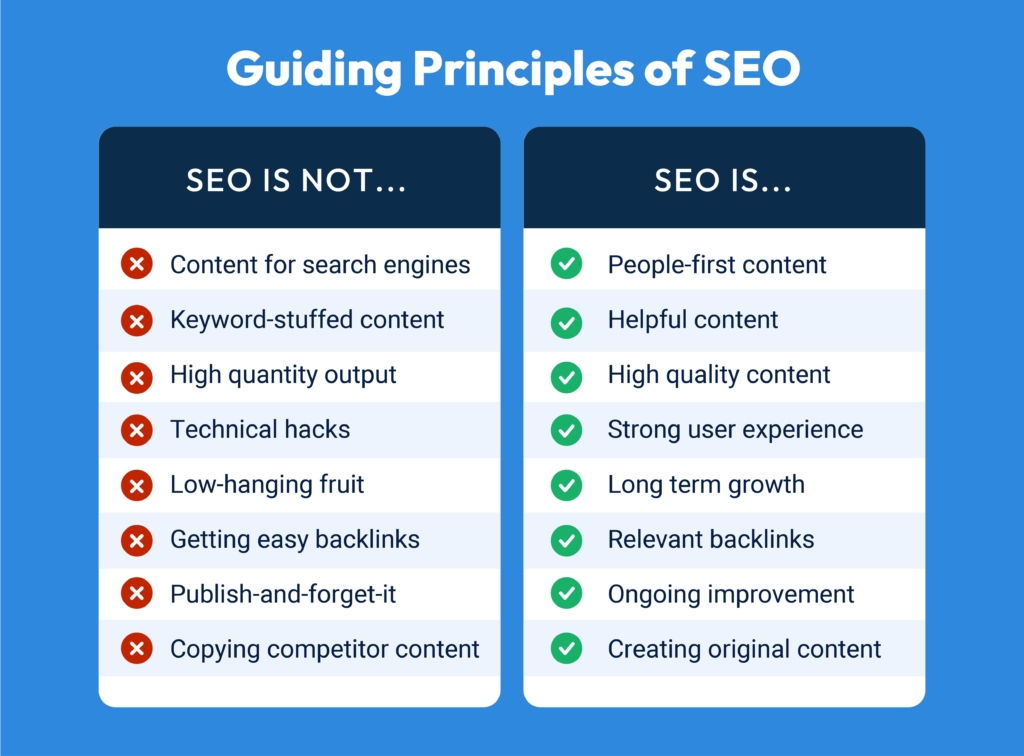
There is no magic formula for getting content to rank, especially as search engine algorithms adapt and change over time. However, there are several fundamental SEO principles that will only help your content perform better:
One of the most common SEO copywriting mistakes is trying to fit too much into one landing page or article. It’s tempting to want to share everything about a particular topic, but that isn’t how people consume information. And if it confuses the reader, it will confuse the search engine.
Each piece of content you publish online needs to answer a specific question. Not only will this be helpful to your reader, but it will show the search engine that your page is highly relevant for particular queries. If there’s more you want your reader to know, you can (and should) add strategic internal links to other website pages.
For example, if a fitness coach wants to publish an article on the best at-home workouts, it’s best if they don’t get sidetracked explaining the benefits of working out. They may have a lot of very helpful information on that subject, but it doesn’t answer the question! If the searcher feels that they’re not getting the information they wanted (and quickly), it will result in high bounce rates and low user satisfaction.
You may have heard the term “long-tail” keywords. “Long-tail” keywords are searches that involve more complex phrases and niche questions. For example, for a remote fitness coach, the phrase “best at-home workouts to build muscle” is a long-tail keyword with more relevance and specificity than a keyword like “best workouts”.
It’s often easier to rank for specific phrases and build authority in your space before moving on to generic keywords that get thousands of searches every day. But remember the key is targeting keywords that are hyper-relevant – not just specific. Pay attention to the questions you already get from your customers and write for those relevant topics first. Steer clear of overly long search phrases with low search volume.
This may sound obvious at first glance, but it’s crucial to pause and think about how people search. As a subject matter expert, you have a particular way of thinking about and understanding your area of expertise. But the content you develop has to align with the way your audience thinks about — and searches for — your topic. This is the fundamental principle behind keyword research.
To rank well, your content should align with the common search phrases people use (keywords), and match the intent behind their search.
Want to learn more about how to find relevant search terms? Check out this guide from Ahrefs on how to do keyword research.
There are two main categories of search intent: educational and commercial. Generally speaking, searchers are either looking for information or to buy a product or service. It’s crucial to identify the reason someone would be searching a particular phrase, so your content is as helpful and relevant to them as possible.
| Search Intent | Educational | Commercial |
|---|---|---|
| Types of search results | How-to guides, informational pages, topical blog posts, YouTube videos | Product category pages, brand landing pages, Google Shopping Feed listings, local landing pages |
| Keyword examples | “how to play guitar” “easy guitar chords” “is guitar easy to learn” | “guitar lessons” “learn guitar online” “guitar teacher near me” “beginner guitar” |
The simplest way to determine search intent is by analyzing search result pages for a keyword. The pages that currently rank for a search query tell you what Google currently finds to be the most relevant content.
For example, if the search results are full of pages with product listings, this tells you the search intent is likely commercial, not informational. Or, if most of the results are “how-to” guides, the searcher is likely looking for step-by-step instructions — a very practical type of educational content.
Pay particular attention to any featured snippets and the “people also ask” section on Google to identify important angles to cover or questions to answer to match searchers’ intent.
Google frequently releases algorithm updates to improve the user experience and discourage low-quality content. To stay ahead of these updates (and the competition), focus your efforts on giving the best possible answer to the questions your target audience is searching.
Pay attention to the pages that currently rank well in organic search results so that you have an idea of what readers want you to cover. But don’t just copy what’s already out there. Consider how you can create more helpful content than what currently exists — both in terms of the content itself and how you present it.
Do you bring a unique angle to your subject? Do you offer readers a more engaging experience? You want to prove to your readers—and by extension Google—that your content is most worth paying attention to.
Google has provided four criteria for evaluating content quality, abbreviated E-E-A-T. These aren’t exactly search engine ranking factors — think of them as guidelines for analyzing how helpful your content is on a broad level.
Experience – Do you as the author have first-hand experience about your subject?
Expertise – Along with experience, does your content show originality of thought and give your audience genuine expert insights?
Authority – Are you recognized in your industry? Why should a search engine or reader believe the information they read on your website?
Trustworthiness – Does your content help users, or is it spammy, malicious, or incorrect?
For more of Google’s recommendations, check out their guide to SEO fundamentals.
Expert, in-depth information isn’t the only component of high-quality content. It also matters how easy the content is to consume.
One of the most important parts of readability is following a clear heading structure so your topic and major points are evident at a glance. From the title of your page to the CTA, each major section and its heading should follow a clear, purposeful outline. This makes it easy for your reader to understand your message, and easier for a search engine to know what’s on the page. You don’t have to sacrifice creativity, but remember each heading and subheading serves a very practical purpose in digital content.
Another way to improve the user experience is to incorporate engaging visual elements. Infographics, for instance, help break up long blocks of text and give the user something they can understand at a glance.
And even if you don’t incorporate graphics, it’s still a good idea to break long paragraphs into short, easy-to-read sections to prevent walls of text that are tiring to read.
Remember that people consume content differently — some people skim, others read every word. Your page should accommodate both types of readers so that no one has to work too hard to get the details they want.
If your page incorporates visual elements like pictures or infographics, include an accurate description of the image known as “alt text”. Alt text shouldn’t be stuffed with keywords — it should simply describe the purpose of the image for the sake of accessibility to users who rely on screen readers. Alt text also helps search engines understand how the image relates to your piece of content.
Working on content SEO doesn’t always mean developing new content! Once you have a collection of web pages, be sure to update any outdated or irrelevant pages, analyze performance metrics, and find opportunities for improvement. For example, if you have a page that ranks 8-20 on Google, this is a good indication that your page has relevant content that would drive even more search traffic with a few more optimizations. Google Search Console is a great tool to use at this stage.
As you dig into the performance metrics of older content, use this time to identify any content gaps. Are there valuable subjects that your competitors continually outrank you on? (Tools such as Ahrefs and SEMrush help with this analysis).
Do you have a lot of organic traffic but no conversions? (You may need to focus on bottom-of-funnel pages).
Search engine-optimized content takes time and effort, and you want to make sure that you spend your resources where they will have the biggest impact.
“Duplicate content” refers to pages on your site with overlapping content. These pages can compete with each other for the same target keywords, bringing down your rankings. Each page on your site, from blog articles to service pages, should have a distinct purpose and distinct content. As you update and add new content to your website, it’s important to keep track of what subjects you have already covered and to give each page its unique place on your website.
Traffic to a page is one of the signals that a piece of content is valuable. If enough people are visiting that page and deriving value from it, the content gains authority. SEO content benefits from coordinated marketing channels that funnel interest surrounding your brand to pages on your website.
If you have a social media presence, for example, you can share some of that momentum with your website by steering followers to check out pages that are relevant to their interests. Email marketing is also a great source of referral traffic that can help your website gain more visibility.
And if you have the opportunity, acquiring quality backlinks (links from relevant websites) helps validate your authority on a particular subject and prove to a search engine that people find your website helpful.
As you might expect, it depends! Remember that SEO is a long-term digital marketing strategy that drives long-term results. SEO success is measured in terms of months and years, not days. You’ll discover what works best for your business through patience, consistency, and testing ideas. The good news is that you can start implementing SEO practices today and make improvements as you go.
SEO is about holistic business growth — establishing your brand as a trusted voice in your industry for years to come.
Kartra is the all in one platform that enables content creators and other entrepreneurs to successfully build online businesses. Find everything you need, all in one place — from a professional landing page builder to membership management software.
A lead management system is a must-have for any business that sells to an online audience. Even if you already have a compelling online presence that drives sales, you need some way of tracking your leads and where they are in the buyer journey — to improve conversion rates and cut down on manual tasks. Read on to discover the top lead management tools in 2024 and the most important lead management features to look for.
Lead management software automates processes involved in gathering sales leads, tracking leads’ progress through the sales cycle, and converting them into paying customers. It includes features such as lead capture forms, lead tagging, lead scoring, and conversion analytics. Most lead management platforms are cloud-based software applications for ease of use.
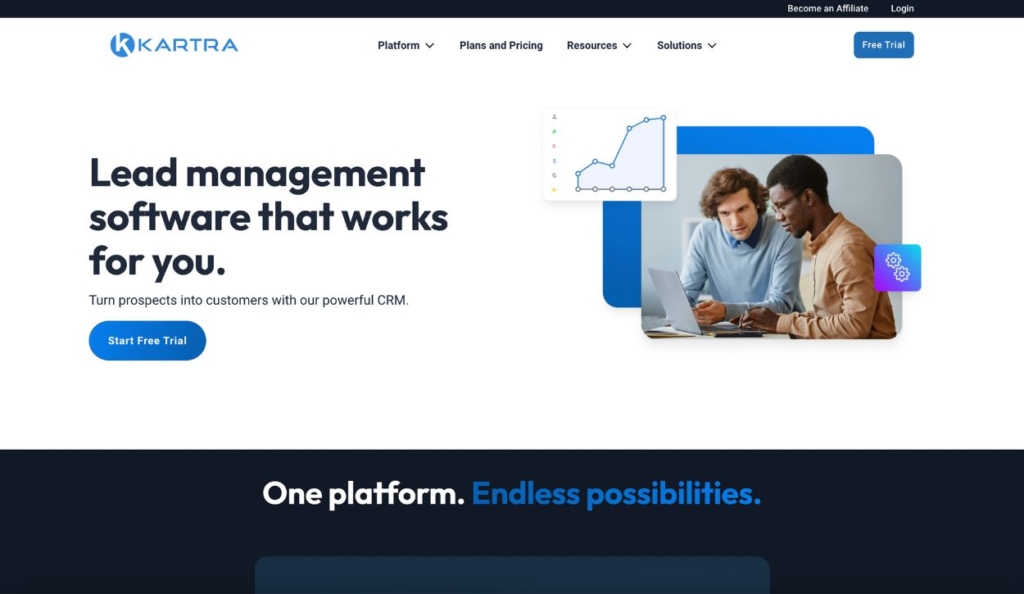
Kartra is an all in one marketing and lead management platform that simplifies and streamlines all of your sales and marketing efforts — not just lead management processes. Kartra users get access to advanced functionalities that include:
Kartra is designed to minimize third-party integrations, with a significant number of native features so you don’t have to stitch together multiple platforms. From lead generation to membership retention, Kartra makes it simple to manage each stage of the customer lifecycle. Instead of being yet another subscription in your software stack, Kartra is built to give you all you need to grow your online business, all in one place.
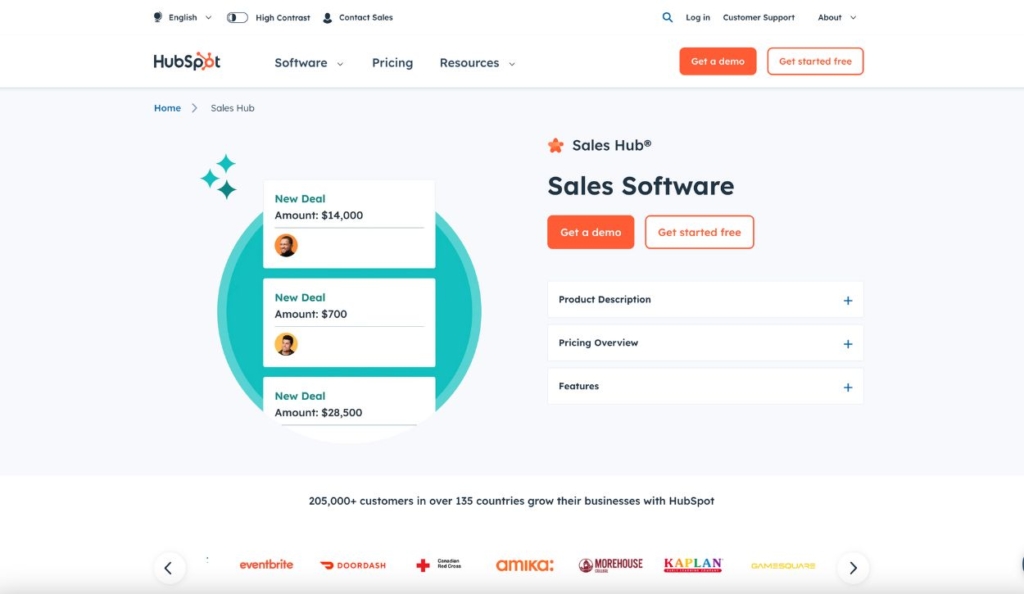
HubSpot offers customer relationship management (CRM) software at a variety of levels, from a free plan to an enterprise plan depending on what functionalities you need. With sales management features that include meeting scheduling and sales forecasting, HubSpot’s CRM is geared toward sales teams who need a system that simplifies their processes and gets everyone on the same page.
The downside of HubSpot’s CRM is the high price point and level of complexity that come with upgraded subscriptions and add-ons. Small and medium-sized businesses who need higher-tiered plans or additional HubSpot sales and marketing tools may find that upgrading or adding on those plans requires paying for many advanced features that go unused.
Lead management software enables businesses of all sizes to nurture potential customers through various stages of the sales process with lead capture, lead tracking, and contact management features.
A CRM (Customer Relationship Management) is a more complex system for automating pipeline management and maintaining relationships with existing customers.
In general, entrepreneurs and small to mid-sized online businesses get a lot of value from lead management software, while businesses with dedicated sales and customer service teams rely on CRMs to stay organized.
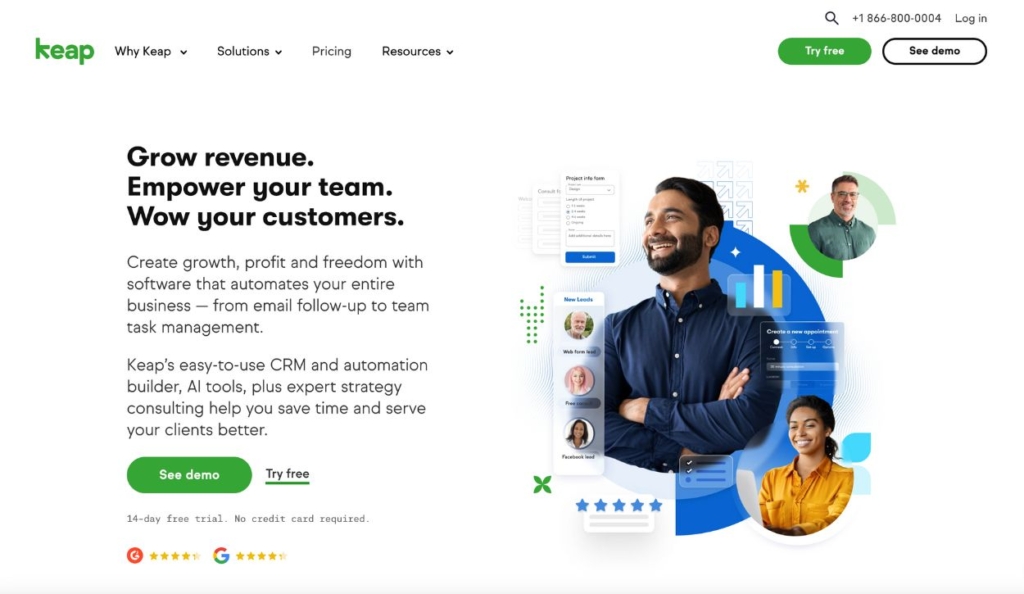
Keap (formerly Infusionsoft) is a CRM software for small businesses that also includes basic marketing and sales functionalities. Users can create custom lead forms, keep track of contacts, and build automated workflows such as personalized follow-up sequences. Keap is known for its user-friendly CRM capabilities, but it’s missing the advanced marketing features and intuitive interface provided by more comprehensive platforms like Kartra.
For example, Keap’s sales funnel-building tools are not as robust as other all in one platforms. Keap is a great CRM system for small businesses, but users may find that Keap’s higher price tag doesn’t have the native capabilities they’d prefer from an all in one marketing platform.
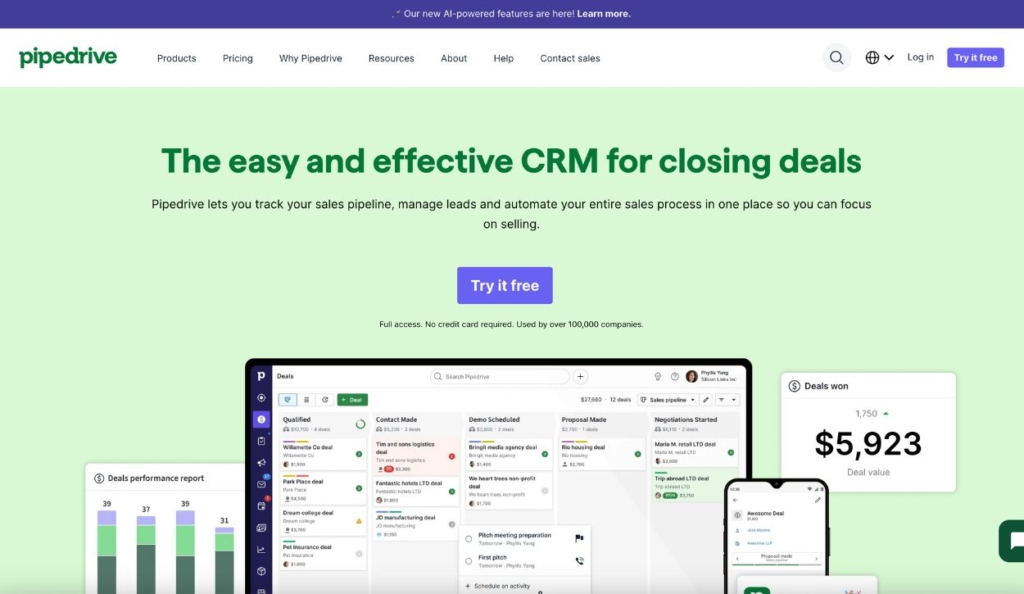
Pipedrive is a CRM and sales automation platform for small businesses. This software helps sales team members stay organized with sales activity tracking and lead management features. Pipedrive’s automation is geared towards sales processes (as opposed to marketing automation), simplifying tasks like email follow-ups and call scheduling.
Pipedrive is not an all in one solution, requiring API integrations to connect with an email marketing platform, membership management software, a website builder, and any other marketing and sales tools needed to run an online business.
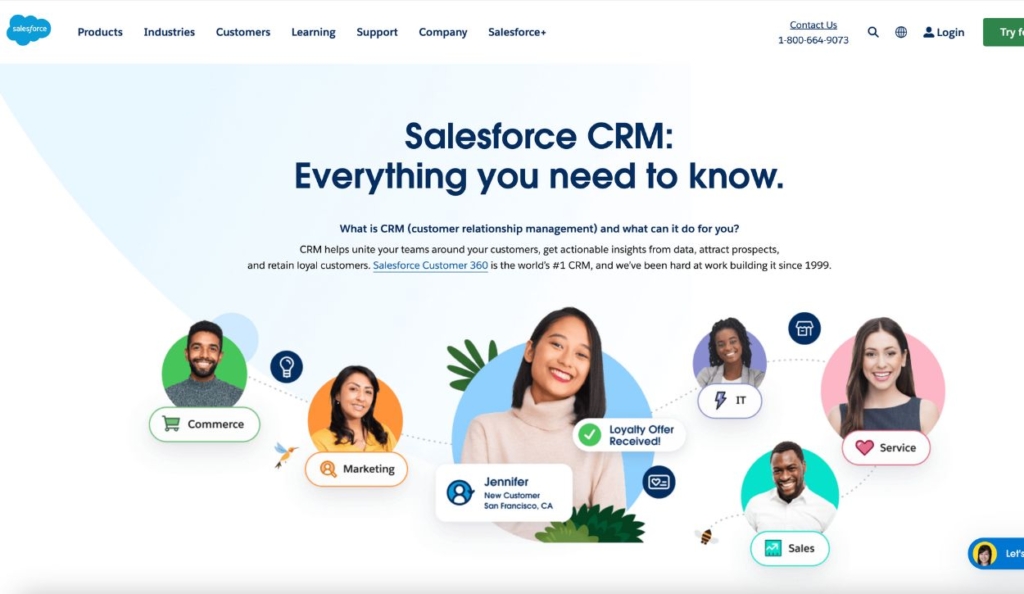
Salesforce is one of the most popular CRMs for large businesses, with extensive capabilities for sales pipeline management and lead management. Users can find all in one marketing, sales, and CRM features on Salesforce, and they can choose from a variety of plans tailored for small businesses all the way to enterprise sales teams.
However, Salesforce is one of the most expensive solutions on the market — especially if it’s being used as an all in one marketing and sales platform. This software ultimately performs best for enterprise companies and is not a practical option for content creators, entrepreneurs, and other types of streamlined online businesses.
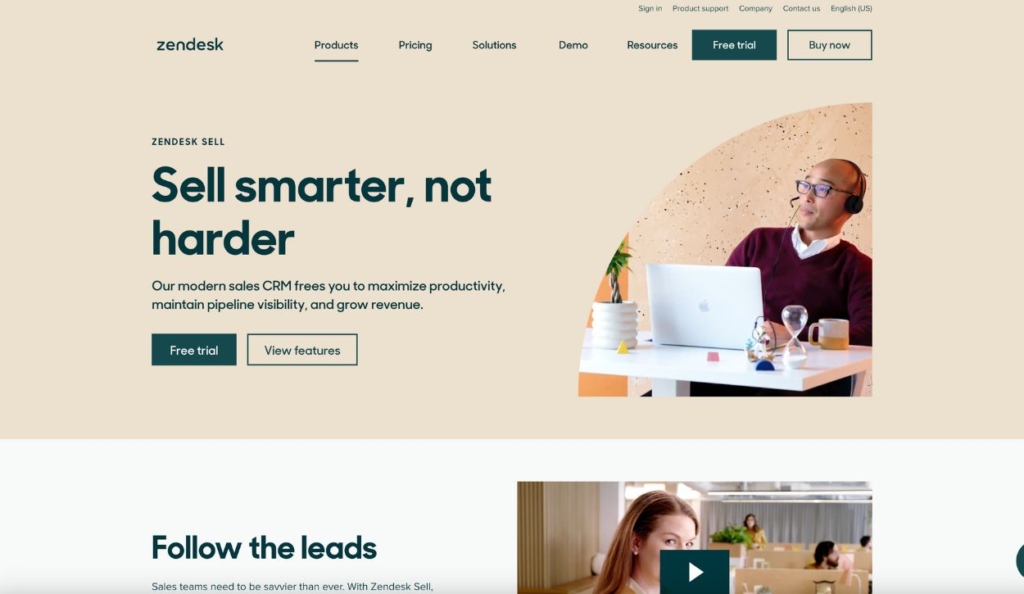
Zendesk is a “customer service solution” for businesses of all sizes. Businesses use Zendesk Suite for customer support, and Zendesk Sell for sales management. Features of Zendesk Sell include contact and deal management, sales activity tracking, and sales engagement tools such as automated email sequences.
Zendesk is all about the customer experience, giving businesses the software they need to build customer relationships and organize behind-the-scenes sales processes. The downside of this platform is that it doesn’t offer all in one marketing or website features that many online business owners, entrepreneurs, and digital creators rely on.
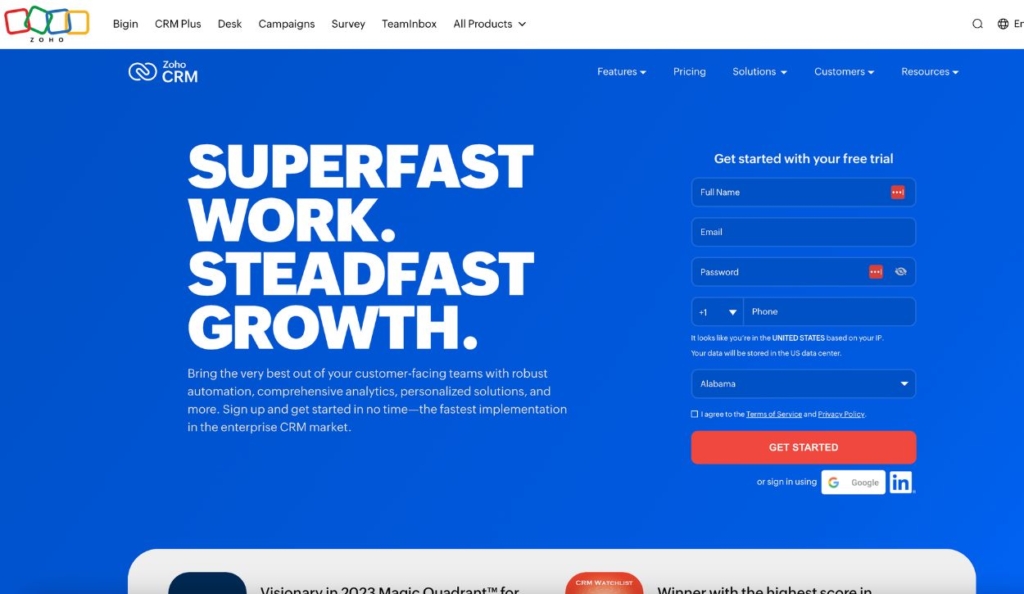
From customer relationship management to accounting, Zoho is a comprehensive software suite for all types of business processes. Zoho users can essentially build their own platform, selecting the Zoho products or plans that make the most sense for their business. Zoho CRM is highly rated for its lead management capabilities, and comes with a mobile app for on-the-go data access. Bigin by Zoho CRM is the recommended Zoho product for small businesses, offering simpler CRM features at a lower price.
While Zoho offers a wide range of customizable plans and products, some users find that integrating Zoho products with each other and with third-party applications can be a complicated and expensive process. It’s easy for subscriptions to add up as businesses upgrade their Zoho products for expanded features. Zoho isn’t as user-friendly and straightforward for smaller businesses as a true all in one platform like Kartra would be.
See the main differences between 2024’s top lead management software in this chart so you can find the platform that best aligns with your business needs:
| Lead Management Software | Best For | Standard Plan Cost (per user) |
|---|---|---|
| Kartra | Comprehensive, all-in-one marketing and lead management for growing businesses | $189/ mo |
| Hubspot CRM | CRM for large businesses with dedicated sales teams | $90/ mo (+ $1500 onboarding fee) |
| Keap | CRM for small businesses, with some marketing features | $229/ mo |
| Pipedrive | CRM and sales pipeline automation for sales teams | $49/ mo |
| Salesforce | CRM and sales pipeline automation for enterprise sales teams | $165/ mo |
| Zendesk | CRM and helpdesk for sales and customer support teams | $55/ mo |
| Zoho CRM | CRM for midsize to large companies | $40/ mo |
Each of the software options on this list comes with features for capturing new leads, tracking prospects’ progress through the buyer journey, and reporting lead conversion data. So how do you choose the best one? To get the most out of your lead management solution, we recommend choosing a platform with the following functionalities:
The ability to tag and score leads is a standard feature of any CRM or lead management platform, but you’ll want to pay attention to the level of customization and ease of use that your software provides. Will you be able to easily assign the categories and values that you want to each prospect? Is this process simple or complicated? Can your software automatically route leads to the best sales and marketing path?
While it’s possible to build a sales funnel manually by combining miscellaneous digital tools like web page builders, email software, and lead management software, an all-in-one platform with native funnel-building software makes the process far more efficient and effective. It also gives you ultimate control over every touchpoint along the customer journey — from the first time someone fills out a web form to their most recent purchase.
With an integrated sequence builder, it’s easy to remove, or re-order events within automated workflows. Want to share a webinar on-demand to follow up on a white paper that a visitor downloaded? Sequence mapping makes it simple to add a trigger that automates the right sequence for that prospective customer. Lead management that integrates seamlessly with your sales funnel builder enables you to create, manage, and adjust workflows with minimal hassle.
Many CRM and lead management tools include basic email functionalities so that sales reps can send messages to leads and set up lead nurturing sequences. But these platforms often require additional subscriptions or integration with third-party apps for more complex email marketing campaigns.
An all in one lead management and marketing platform like Kartra makes it simple to set up all types of automated email campaigns that integrate with your sales funnels. Whether you’re just checking in with a lead or nurturing a sale with a complex email sequence, it’s helpful if your platform is built for both lead management and email marketing.
Every lead management platform claims to offer data visibility and reports with key sales metrics. Consider what data matters the most to your business operations to make sure those reports include all the data points you need. You’ll also want to make sure those reports integrate well with your other analytics dashboards.
An all in one platform, for example, provides real-time data insights across multiple marketing channels with little to no third-party integrations — something a dedicated CRM wouldn’t be able to do.
Every lead management or CRM platform has its limitations, requiring integrations to stand in the gap. Marketing solutions such as Zapier attempt to solve this problem, integrating various applications such as lead management, email, and membership platforms. But this stack of software becomes hard to manage.
Lead management software with native capabilities saves time and money, streamlining subscriptions and giving you more control over your marketing and sales efforts.
Kartra enables business owners to generate, manage, and convert leads in one integrated platform. With a full slate of native sales and marketing features, Kartra users don’t have to pay for multiple subscriptions or piece together multiple software programs.
Instead, you get a bird’s eye view of the whole buyer journey and the ability to set up powerful, automated sales funnels that don’t need an entire sales team to convert leads. Already tracking leads somewhere else? Rest assured you can effortlessly import your contacts into Kartra’s system from various sources — ensuring a unified database for streamlined management.
Cross-selling and upselling are two popular marketing strategies designed to increase profits during the sales process.
Both techniques are effective strategies for increasing the lifetime value of a customer and are used by online and offline businesses. However, there are five key differences between cross-selling and upselling that you need to understand so you can choose the best tactics for your sales funnel.
Learn about how to build a sales funnel in our step-by-step guide
An upsell is an offer made to prospective customers inviting them to purchase an upgrade, usually at the time of checkout or purchase. Upselling increases the average order value (AOV) of a sale by enticing customers to upgrade to a higher-value version of the product or to choose additional features that enhance their initial purchase.
An online course creator could create tiered membership levels. A basic or standard membership would provide access to the core content and basic features of the online course. An upsell offer for an upgraded membership level could include additional benefits such as exclusive content, live coaching sessions, personalized support, or advanced features.
Pricing pages, pop-ups, and check-out page callouts can be used throughout the funnel to highlight the value and unique advantages of the upgraded membership.
An online course creator could create tiered membership levels. A basic or standard membership would provide access to the core content and basic features of the online course. An upsell offer for an upgraded membership level could include additional benefits such as exclusive content, live coaching sessions, personalized support, or advanced features.
Pricing pages, pop-ups, and check-out page callouts can be used throughout the funnel to highlight the value and unique advantages of the upgraded membership.
Many companies looking for a new website design need a logo design and other creative services as well. Designers can increase the value of a project by offering to bundle together multiple services like web design, logo design, and business cards for a lower price than purchasing them separately. It’s a win-win for the designer and client!
Both upselling and cross-selling are effective digital marketing tactics, each playing a different role in your sales strategy. Understanding these five differentiators will help you determine when to implement one or the other.
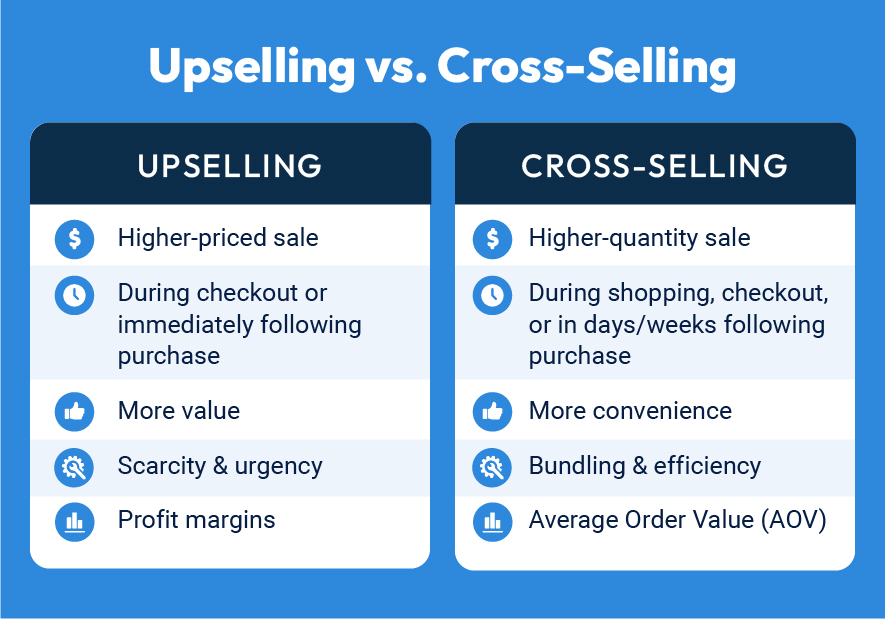
The most basic difference between cross-selling and upselling is the type of offer. In an upsell, the goal is to sell a higher-priced or higher-end version of the product, while cross-selling offers encourage customers to purchase additional items directly related to the new products they’re buying.
Cross-selling and upselling can occur at any time along the customer journey; however, most businesses use them strategically during the bottom-of-funnel sales process to increase the AOV.
An upsell offer for a premium version of a product is most effective on the checkout page — or immediately after the initial purchase is completed. Once someone makes a purchase, they’ll be open to spending even more money.Cross-selling opportunities are typically placed on the product page or during the checkout process in the form of related products and/or featured bundles. Unlike upselling, cross-selling can also be used to encourage additional purchases in the days and weeks following the initial purchase. Sales funnel software helps to segment existing customers into lists based on their purchase history so that you can market relevant products to them.
While an upsell is often a great value and in the customer’s best interests, the sales pitch may not always give that impression. For this type of offer to be done right, the customer needs to see the upsell as an incredible value compared to the original product. If poorly presented, the offer can feel like an overly aggressive marketing strategy that puts the company’s bottom line first. This outcome results in lower conversion rates and a poor customer experience.
Before making a strong upsell push, it’s important to develop a robust understanding of customers’ needs by testing your messaging to learn what resonates with them best.
Cross-selling rarely has this challenge. Cross-selling strategies such as product recommendations are usually perceived positively. They frequently improve customer satisfaction and customer retention, which then increases customer lifetime value.
Upsell and cross-sell funnels perform best when the sales approach is tailored to the funnel strategy.
Scarcity is a technique commonly used to create urgency in upsell opportunities. Limited-time offers or openings put pressure on the customer to upgrade their purchase or risk losing the opportunity. For example, a coach’s “inner circle” members might be limited to a certain number of open spots each year, or special bonuses may expire 24 hours after the initial purchase.
One of the most popular cross-selling techniques is bundling—a sales tactic that offers a discount on related products if they’re bought together. For example, an individual product may be priced at $40 with a cross-sell offer to get three for $100. Convenience, speed, or shipping discounts are also effective ways to add value for customers who purchase multiple products or services.
A proper upsell offer should be designed to increase a company’s profit margins. Be sure to track the profit margin on the upsell to ensure that the added features not only provide added value to the customer but also create economy of scale for you.
The primary metric to be tracked when cross-selling is the AOV, or average order value. If your product recommendations and bundling strategies are working, the average sale for each transaction should increase over time. Funnel software’s automation can organize each customer’s purchasing habits and help identify new cross-selling opportunities.
Explore funnel ideas in our guide: 7 Examples of Digital Sales Funnels That Actually Generate Leads
Whether you choose an upsell or cross-sell funnel — or a combination of both — your marketing strategy will depend on your business structure and goals:
A photographer offering a newborn photoshoot could upsell a multi-session package covering the baby’s milestones throughout the first year of life, and cross-sell a “First Year” photo album for the family to receive after the first birthday.
How to build the perfect upsell or cross-sell funnel looks different for every business, but here are a few key principles to follow as you implement these digital marketing strategies.
Successfully persuading a customer to make a purchase decision requires an in-depth understanding of who they are. Your upsell or cross-sell offer needs to resonate with what your customers value, their pain points, and their stage of the buyer journey. Having a thorough understanding of your audience is the foundation of any successful sales funnel.
Build out buyer personas based on customer feedback, testimonials, surveys, quizzes, purchase behavior, and your own audience research. And remember — you’ll need to continue gathering customer data as your business grows to make sure your offers are still relevant.
The first version of your upsell or cross-sell offer will be an educated guess. You’ll have to make some assumptions about what design, medium, and messaging will capture your audience’s attention. To craft the perfect upsell or cross-sell sequence, incorporate regular A/B testing and implement what you learn about the best way to engage your customer base.
From purchase add-ons to automated email sequences, upselling and cross-selling efforts can be as simple or complex as you need them to be. Your funnel software should give you all the tools you need to set up automated funnels that drive more sales and improve customer loyalty.
Whether you’re a small business owner, online course creator, coach, or B2B service provider, high-quality sales funnel software makes building automated, effective digital funnels fast and easy.
Kartra is an all-in-one marketing platform with access to all the features you need for planning, creating, optimizing, and tracking your marketing campaign performance. Plus, the funnel simulation feature lets you project your funnel’s potential results to see which types of funnels will work best for your offer!
Build marketing funnels in minutes with the best all-in-one sales funnel software.
Here’s a riddle for you: what is something you cannot physically touch but can access from anywhere? A digital product!
Physical products are built in factories with workers, machines, and massive overhead costs. But digital products? You can build those right on your laptop.
Thanks to tech getting better all the time and more people shopping from their sofas, ecommerce digital products are booming. And for those with something to teach or share, it’s a great time to earn.
Whether you’re a coach, consultant, or creator, digital products let you reach people all over the globe. This means you can help more people and make more money, all from your personal computer.
So let’s dive into the basics of digital goods and how you can turn them into profitable digital products.
In this article:
Digital products offer fantastic perks for anyone looking to share their knowledge or creativity online. Here’s why digital products could be your ticket to business growth:
Scaling up your business with digital products is straightforward and efficient. You can multiply your impact and reach without the complexities associated with physical goods.
Once you’ve created a digital product, you can sell it over and over again, without any extra costs. Unlike physical goods, there’s no need to worry about running out of stock.
Sell your products to anyone, anywhere. No shipping, no fuss! This means your business can grow bigger and faster on an international scale.

Embracing digital products not only streamlines your operations but also significantly cuts down on costs. Digital products can simplify your business processes while boosting profitability.
Digital products live online, so you don’t need to keep any inventory. This cuts down on costs and space.
Forget about the headaches of shipping and handling. Digital products mean fewer logistics and more time to focus on creating more products.
Digital downloads provide the instant gratification that modern day customers expect. Offering quick and easy access to your digital files can enhance customer satisfaction and encourage loyalty.
Your customers can download and use your products right away. None of this “ships in 5-7 business days.” They get your product NOW. Fast delivery equals happy customers.
When customers are happy, there’s a good chance they’ll buy from you again and might even leave a great review to help spread the word.

Embrace the power of automation to turn your digital product business into a 24/7 revenue-generating machine. Setting up automated systems can keep your earnings flowing day and night.
Set up systems one time to handle tasks such as sales processing and email marketing automatically and let them run. Your own website can make sales day and night without you having to lift a finger.
With subscriptions or memberships, you can keep earning from the same customers, providing a stable and predictable income.
In the fast-paced world of business, staying agile and innovative is key to success. Selling a digital product makes that easy.
Easily tweak your products to stay ahead of market trends or respond to customer feedback.
Use upselling or cross-selling to boost your earnings. For example, you could sell an ebook and then cross-sell an exclusive webinar at a special price to sweeten the deal.
Digital products aren’t just a smart choice — they’re a strategic move for anyone looking to make a mark in today’s digital-first world. Whether you’re just starting out or you’re ready to take your online business to the next level, digital products open the door to financial freedom and business growth.
So you know why selling a digital product is a good idea. But which one should you sell?
No matter the type of digital product you choose to sell on your ecommerce platform, the number one rule for all of them should be: create captivating content. The best content creators design assets that grab and keep attention. Your content should be clear, engaging, and designed to make learning fun. Set that as your north star and follow it all the way to success.
Using a free design site like Canva can help make your products pop. Including bold fonts and engaging stock photos can help share your knowledge in a dynamic way.Here’s how you can spot those winning ideas that customers will love and that’ll make your online store a hit.

Diving into the digital product space starts with picking the right product. Think about what you know and see if there’s a gap in the market that matches your expertise. Some top-selling digital product categories are:
Online courses are a great way to share your skills. Whether it’s a course on leadership or a tutorial on how to start a podcast, the key is offering valuable knowledge that you’re passionate about.
An e-learning course could also be a part of a larger membership site for your audience that includes exclusive additional resources like live Q&A webinars and a community message board. There are several membership site pricing options for course creators you can consider.
People love templates because they simplify complicated tasks they don’t have to do from scratch. Whether it’s a budget tracker or a resume builder, these tools help save time and reduce stress.
An HR professional could offer “Employee Onboarding Checklists,” designed to streamline the process of integrating new employees into an organization, ensuring nothing is overlooked.

eBooks package your knowledge into easy-to-read formats, perfect for those who like to learn at their own pace. They can range from simple how-to guides to in-depth explorations of complex topics. If you want to learn more, here’s a step-by-step guide for how to write a successful eBook.
Podcasts let you talk directly to your target audience, making them feel like they’re part of the conversation. They’re great for storytelling or deep dives into niche topics.
Printables like planners or educational worksheets are extremely popular for their convenience and practicality. They’re easy to download and use right away, perfect for quick learning or organizing.
By choosing the right digital product based on what you know and love, you’re laying the groundwork for a successful digital venture.
Starting your journey with digital products is exciting and full of potential. As we’ve seen, there’s a huge opportunity for making scalable, passive income by sharing your expertise online. Another great aspect about making your first digital product sales is that you’re creating a group of customers primed for upselling and cross selling.

To make your digital product venture successful, keep these points in mind:
Start with what you know. Use your knowledge to create unique and useful digital products.
Make sure whatever you produce — whether it’s a course, ebook, or template — is engaging, helpful, and worth your audience’s time.
Use your online presence and digital marketing skills to get your products in front of the right people.
Look at success stories for inspiration and adapt their winning strategies to suit your products.
There’s no better time to start than now. Maybe sketch out some ideas for your first digital product or dive into some market research to figure out what your potential customers really need. With some hard work, creativity, and focus, you’re set to build a rewarding digital product business.
Remember: selling digital products isn’t just about profits – it’s about creating real value for your customers’ lives or businesses. Keep your mission in focus, stay open to feedback, and continually refine what you offer.
Kartra is here to help you turn your digital product ideas into a thriving digital business.
From crafting conversion-optimized landing pages to setting up automated email campaigns, Kartra has everything you need to efficiently run and grow your digital product business. Want to get faster and easier marketing results? Read about how to automate your digital marketing with Kartra.
Selling online courses is a lucrative opportunity for content creators, career educators, and field experts who wish to monetize their knowledge. Online courses are incredibly versatile digital products — able to be marketed as lead magnets, standalone products, or membership experiences. They can be as simple or complex as you want, ranging from evergreen video tutorials to live events for cohorts of students.
But how do you turn your idea into an online business that actually makes money? Find out by following this step-by-step guide on how to sell online courses:
Before you do anything else, it’s imperative to start with the specific purpose you want your course to fulfill. There are a variety of ways for an online course to drive revenue. Courses can be…
The purpose of an online course drives both the content and the sales strategy. It should determine everything from the course topic to digital marketing tactics.
For example, some courses are sold as high-value, high-ticket experiences. The course creator won’t need thousands of sales to make a profit, just a few eager students who will be excited to give referrals to their network. However, the course will need to meet expectations and deliver significant value for the audience. Other online courses are low-cost, low-commitment digital products meant to raise brand awareness and build trust. This type of course can be more basic, but needs a significant number of sign-ups to accomplish its purpose.
Chances are, you have a few great course ideas you’re thinking about. To narrow in on the perfect course topic, ask these three questions:
It’s difficult to find success if any one of these elements is missing. For instance, there might be a topic that takes advantage of your expertise and is relevant to your audience, but it’s too basic to sell at a premium price. It won’t fulfill its purpose.
Conducting competitor research and audience research is crucial in this stage. Learn what resources already exist and analyze how you can bring something new to the table. Test topic ideas through surveys and quizzes if you have an existing email list or social media following. Some course creators even pre-sell their courses to validate their ideas and ensure they’ll have an engaged audience.
Your value proposition clearly states what your course does and for whom. While similar to the course topic and the course goal, the value proposition goes a step further. It requires you to know exactly who you want to teach and what your course will accomplish in your students’ lives. The value proposition is the selling point of your course. It’s what sets you apart from competitors and determines the quality of your course.
Whether your course is simple and straightforward or involves a complex assortment of content types, you’ll want to approach online course creation with an eye toward your sales and marketing plan. Keep in mind how you can repurpose parts of your course to serve as lead magnets, giveaways, teasers, or other promotional content.
For example, the course’s introductory lesson could be repurposed as teaser content for your social media accounts or offered as a downloadable course sample on your website. It takes a lot of work to develop course modules, so take advantage of every opportunity to leverage the content you’re already creating. Forward-thinking will make marketing and selling the course a lot easier down the road!
How your course is packaged and priced is a significant part of your sales strategy. Not only is pricing about creating a profitable online course, but your choice will influence brand perception, the student experience, and marketing success.
Here are several pricing models for course creators:
As you hone in on the price and pricing model, remember to go back to the course’s purpose. What do you need it to accomplish for your brand? What is it going to accomplish for your students? Conduct market research to analyze competitor pricing and do in-depth audience research to judge how much students will be willing to pay for your course. And always remember that the price of your online course needs to accurately reflect its value.
Want to avoid overpromising or underselling your course? Check out this guide on how to price an online course.
To make real money from an online course, the best place to sell it is your own website. Selling courses on your website gives you exclusive ownership of your products and your audience — allowing you to take home the profits and build a scalable brand.
Course creators will need a membership site platform, or online course platform, that gates course content behind a paywall. Examples include Kartra, Kajabi, Thinkific, Teachable, and Podia. With intuitive membership software, it’s easy to upload video content, ebooks, downloadable PDFs, and any other course materials. You can even set membership tiers where paying customers only get access to the course materials that belong to their plan.
An effective course sales page facilitates the sale, giving interested students the information they need to make a purchase decision. The page should walk potential customers through the benefits of your course, what to expect, and where to sign up. Be sure to include social proof for added credibility — such as reviews, testimonials, or success stories. This dedicated landing page will be the foundation of your sales funnel!
A “sales funnel” simply refers to the multiple stages that prospects go through before they make a purchase decision. First, they have to become aware of your brand (top of the funnel), then prospects develop an interest in your brand (middle of the funnel), and finally, they decide they need your product or service (bottom of the funnel).
Course creators need to align their marketing and sales strategies with each stage of the funnel. Map out the buyer journey your ideal customer will take, from discovery to decision. Identify your audience’s values, needs, pain points, possible objections, gaps in information, and anything else that plays a role in their purchase decision. Your sales and marketing efforts should be aligned with this research — meeting your audience where they are and giving them all the information they need to purchase from you.
Top of funnel: A life coach posts teaser videos of course material to raise awareness. Each post is linked to a dedicated landing page about the course.
Middle of funnel: As interested prospects visit the coach’s website, a pop-up form offers the first full lesson as a freebie in exchange for their email address.
Bottom of funnel: Everyone who signs up for the free lesson receives an automated email sequence with information about the course along with student testimonials. The sequence ends with a discount code and a CTA to sign up for the course on the sales page.
Unless you’ve already amassed a brand following, the initial stage of the sales funnel can be intimidating. How do you get an audience to notice your first online course? The best marketing strategies for your specific course will depend on numerous factors — including the course price, the audience’s values and needs, and your budget.
Here are a few course promotional tactics to consider:
Remember to focus on the quality of your leads and not the quantity. Based on the predicted conversion rate, determine your ideal number of purchases per month and then how many leads you’ll need to get those purchases. Pour your efforts into getting just those leads. Not everyone needs to know about your course — just your target audience!
Develop a holistic marketing plan with our guide: Everything You Need to Know to Market Your Online Course.
There are three main types of course publishing platforms in the e-learning world: independent membership sites, online course marketplaces, and learning management systems. Membership websites give content creators the most control over their products, but it’s important to understand the purposes of alternative platforms:
A massive open online course (MOOC) is a course marketplace that educates large numbers of online students on a wide range of subjects. Not intended for independent course creators, a MOOC (such as Udemy or Skillshare) is its own platform with its own member base. Educators upload either paid or free courses to these platforms for online learners to access.
A learning management system (LMS) is used primarily by schools or businesses to facilitate online classwork and training programs. It integrates more administrative tools than an online course platform and is not intended for independent course creators. Popular learning management systems include Canvas, Google Classroom, and WordPress LMS plugins like Learndash.
Kartra is the best online course software for content creators. This all-in-one membership and marketing platform gives you all the tools you need to build and sell a successful online course in a single subscription. Key Kartra features for creators include:
A comprehensive platform like Kartra means you don’t have to stitch together multiple software subscriptions to sell your course. Instead, you can publish the materials, manage students, and market your course from the same place. Kartra empowers you to deliver a professional online learning experience — and gives you all the marketing tools you need to scale your course business!